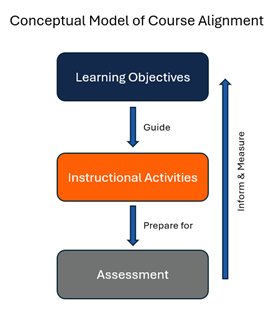Course Alignment
Course Alignment
In the course design context, alignment refers to the systematic and intentional integration of all critical course elements to ensure they work coherently towards a common goal: student achievement of clearly defined learning objectives. When a course is truly aligned, every component, from the overarching course goals to the daily activities and assessments, serves a deliberate purpose in the student’s learning journey.
At its core, course alignment addresses the fundamental question: “What do we want our students to learn, and how will we know they have learned it?” It ensures the consistency among the intended learning objectives (the desired and observable behaviors, skills, and attitudes), the instructional activities (teaching/learning activities that learners will learn and practice the desired knowledge and skills), and the assessment (tasks and methods that reveal how well learners have learned).

Alignment occurs at two levels: the course level and the module level. At the course level, module outcomes should be aligned to at least one course learning outcome. At the module level, assessments/rubrics, learning activities, and instructional materials should be aligned to one or more module learning outcomes. If components of a course are not aligned at both the module and course levels, it can impact students’ motivation and learning.
Course Alignment Table: Matching Objectives, Assessments, and Instructional Activities
The following table illustrates how different types of learning objectives align with appropriate assessments and instructional activities in both classroom and online settings. It serves as a practical tool for course design and teaching planning.
| Learning Objective | Examples of Assessments | How to Measure | Instructional Activities (In-Class or Online) |
|---|---|---|---|
| Remember Students will be able to: identify define recall | Objective test items that require students to recall or recognize information such as weekly knowledge checks/practice exams. Question types: Fill-in the Blank Multiple Choice items with question stems such as, “what is a…”, or “which of the following is the definition of) Labeling diagrams Reciting (orally, musically, or in writing) | Accuracy – correct vs number of errors Item analysis for patterns (at the class level, are there items that had higher error rates? Did some items result in the same errors?) | Interactive quiz games (e.g., Kahoot, Poll Everywhere) Flashcards or memory recall drills Self-paced online review quizzes Gallery walk of key terms |
| Understand Students will be able to: interpret exemplify classify summarize infer compare explain discuss | Assessments such as papers, oral/written exam questions, problems, concept maps, and homework assignments that require (oral or written): Summarizing readings, films, speeches, etc. Comparing and/or contrasting two or more theories, events, processes, etc. Classifying or categorizing cases, elements, events, etc., using established criteria Paraphrasing documents or speeches Finding or identifying examples or illustrations of a concept, principle | Rubrics evaluating clarity, accuracy, completeness | Think-pair-share or breakout room discussions Online forums or annotation tools (e.g., Perusall, hypothes.is) Concept-mapping tools (e.g., Lucidchart, MindMeister, Google Drawings) Group classification or sorting activities |
| Apply Students will be able to: execute implement | Assessments that require students to use procedures to solve or complete familiar or unfamiliar tasks; may also require students to determine which procedure(s) are most appropriate for a given task. Activities include: Problem sets, performances, labs, Prototyping, Simulations, | Accuracy scores Check lists Rubrics | Role-playing or scenario-based practice Virtual labs or simulations Case walkthroughs with procedural steps Scaffolded problem-solving sessions |
| Analyze Students will be able to: differentiate organize attribute | Assessments that require students to discriminate or select relevant from irrelevant parts, determine how elements function together, or determine bias, values or underlying intent in presented materials. Example assessments include: Case studies, Critiques, Labs, Papers, Projects, Debates, Concept Maps | Rubrics, scored by instructor, juries, external clients, employers, internship supervisor, etc. | Structured debates (online or in class) Collaborative analysis of data or texts Diagramming cause-effect relationships Online jigsaw activities |
| Evaluate Students will be able to: check critique | Assessments that require students to test, monitor, judge or critique readings, performances, or products against established criteria or standards. Examples include: Journals, Diaries, Critiques, Problem Sets, Product Reviews, Case Studies. | Rubrics, scored by instructor, juries, external clients, employers, internship supervisor, etc. | Peer review with guided rubrics Critique workshops Discussion boards for evaluating cases Self-assessment with checklists |
| Create Students will be able to: generate plan produce | Assessments that require students to make, build, design or generate something new. Examples include: research projects, musical compositions, performances, essays, business plans, website designs, prototyping, set designs | Rubrics, scored by instructor, juries, external clients, employers, internship supervisor, etc. | Design thinking or brainstorming sessions Collaborative wikis or project management tools (e.g., Trello, Miro) Final project studio time or peer feedback loops Video or podcast creation |
References
Biggs, J., & Tang, C. (2011). Teaching for Quality Learning at University (4th ed.). Open University Press.
Carnegie Mellon University. (n.d.). Assess Teaching & learning: Alignment. Eberly Center: Teaching Excellence & Educational Innovation.
